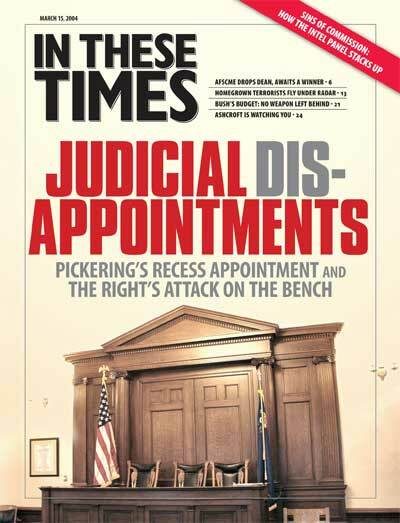With a stalled economy and ongoing attacks against U.S. troops, judicial appointments seemingly lack the immediacy and scope to register among Americans’ concerns this election season.
But relegating the president’s power to make lifetime appointments to the lower tiers of political consideration sets dangerous precedent — and could impact the rights of ordinary citizens for decades to come.
Federal judges play a critical role on such issues as civil rights, reproductive rights, and environmental and consumer protections. And as the recess appointment of Charles W. Pickering Sr. most recently demonstrated, President Bush is bent on packing the federal courts with ideological extremists who have shown a willingness to rewrite statues, distort precedent, and misrepresent facts to justify positions against many of our treasured rights and protections.
Republican appointees now comprise 53 percent of the federal judiciary and are in the majority on 10 of 13 circuit courts. Given vacancies and pending nominees, by the end of the year Republicans could gain the majority on all but one.
President Bush relentlessly pushes to pack the courts, and he has not shown the same commitment to diversity demonstrated by President Clinton. Of Clinton’s 440 judicial nominees, 131 were women (30 percent) and 112 (25 percent) were racial or ethnic minorities. Of President Bush’s 216 nominees to date, 46 (21 percent) are women and 40 (19 percent) are minorities.
Although Democrats have been able to block the worst of the nominees, Bush already has made enough lifetime appointments to leave an indelible mark on the federal judiciary — and there is no reason to believe that his campaign to stack the courts will abate in an election year.
The Republican Party’s right wing has long recognized the role of federal courts in deciding public-interest and civil rights cases. For this constituency the judicial nominations process is a critical factor in determining how, and whether, they vote. In this presidential term, we also have witnessed the increasing involvement of another powerful Bush constituency — the business lobby, which is financing private-sector campaigns to confirm nominees. Like Ronald Reagan, Bush has used his judicial nominations to shore up his right-wing base and to increase fundraising. Republican strategist Karl Rove recently spoke about the need to invoke judicial nominees to reach and mobilize 4 million disaffected fundamentalist voters.
So determined is this president to demonstrate this commitment to remake the federal bench to his right-wing base that he has nominated numerous people lacking in legal distinction or experience — leading the American Bar Association’s Standing Committee on the Federal Judiciary to draw the line with some of the more flagrantly inexperienced and unqualified nominees.
Other nominees have engaged in activities that violate canons of legal and judicial ethics. For example, one of President Bush’s appointees to a Texas district court, Ron Clark, reportedly asked the White House not to sign his official commission papers — a routine ministerial action — after the Senate confirmed him so that he could continue campaigning for reelection to the Texas legislature. Such actions clearly violate ethics rules forbidding judges and nominees from campaigning for political office.
Acrimony in the Senate
Even without a much-anticipated Supreme Court retirement, 2003 proved to be one of the most acrimonious years for judicial nominations — topped by revelations in January that Republican Judiciary Committee staffers spent the last year infiltrating Democrats’ computers to monitor secret strategy memos and to pass along copies to right-wing media.
Senate Republicans also responded to Democrats’ efforts to perform their constitutional duty of advise and consent by arbitrarily reversing or ignoring longstanding rules and practices to grease the path to confirmation for Bush nominees.
Democrats remained committed to blocking the president’s most extreme nominees, and their six filibusters fueled the rage of Senate Republicans, prompting them to threaten to eliminate the stall tactic.
Spurring Democrats’ anger is Republican hypocrisy in complaining of obstructionism, given the 63 highly capable, moderate Clinton nominees who were never confirmed. The rancor culminated as Republicans staged a 30-hour “reverse filibuster” in mid-November to protest Democrats’ persistence. The debate ended in failed cloture votes to halt debate on three of the president’s most controversial nominees.
During the six years Republicans controlled the Senate during Clinton’s presidency, Judiciary Committee Chairman Orrin Hatch gave homestate senators absolute veto power and expanded the blue slip policy to allow senators to block nominees they opposed. The blue slip form itself, given to homestate senators for their feedback on nominees, said that no nomination would move without the consent of both homestate senators.
That was then.
In 2003, with a Republican in the White House and the Democrats making it clear that their loss of the Senate would not result in a cakewalk for Bush nominees, Senate Republicans systematically dispensed with all rules and threatened to employ the so-called “nuclear option” to abolish judicial filibusters. However, this option, which would likely lead to Democrats shutting down the legislative body, lacks the support of all Republicans, some of whom recognize that they will someday lose control of the Senate and might desire what has always been the minority party’s most powerful tool.
Continuing the court-packing agenda, Republican leadership moved forward with votes despite ongoing bipartisan investigations. The most flagrant example of this departure from practice and Senate responsibility occurred in the case of Alabama Attorney General William H. Pryor Jr. The committee pursued evidence that he solicited contributions for the Republican Attorneys General Association (RAGA) from companies doing business in the state. As serious as the alleged solicitations appeared and notwithstanding the pending investigation, the committee moved forward with the vote, which went 10-9 along party lines. The unresolved investigation provided Democrats with further justification for the subsequent filibuster on the Senate floor.
Politicizing the process
The president used Democrats’ rejection of Pickering and Priscilla Owen in 2002 to urge his right-wing base to return Republicans to the majority in 2002. Following Republican success in that election, the judicial selection process began to be used in service of the president’s reelection effort. In an effort to shore up his right-wing base and recapture the White House, President Bush re-nominated all pending nominees in January 2003. And by nominating such lightning rods as Pryor and White House Counsel Brett Kavanaugh, the administration was offering more reassurance to the right wing that sympathetic judges would be appointed.
Early indications were that Bush wanted to name the first Hispanic to the U.S. Supreme Court, and it was widely believed the strategy was to position Miguel Estrada for that appointment by putting him on the D.C. Circuit Court. When it became clear that the Democrats would resist Estrada’s nomination to the second-highest court in the country, Republicans charged Democrats with an anti-Hispanic bias, a patently absurd accusation given the large number of Clinton’s Latino nominees who were blocked by Republicans. Through repeated cloture, Republicans sought to draw Hispanic voters’ attention to Bush’s embattled nominee. Supporters of the president’s nominees attempted to court other constituencies through specious attacks on Democrats. It was Hatch who asked Pryor his religion, and when Pryor responded that he was Catholic, he then accused Democrats of opposing him for his sincerely held religious beliefs on abortion.
Looking ahead
Bush’s reelection would provide the opportunity to appoint at least three Supreme Court justices. Based on Bush’s statements on justices he likes and the kind of judges he has nominated, all indications show his nominees would be in the mold of Antonin Scalia and Clarence Thomas. A second Bush term would cement the Republicans’ hold on the federal judiciary for decades to come.






